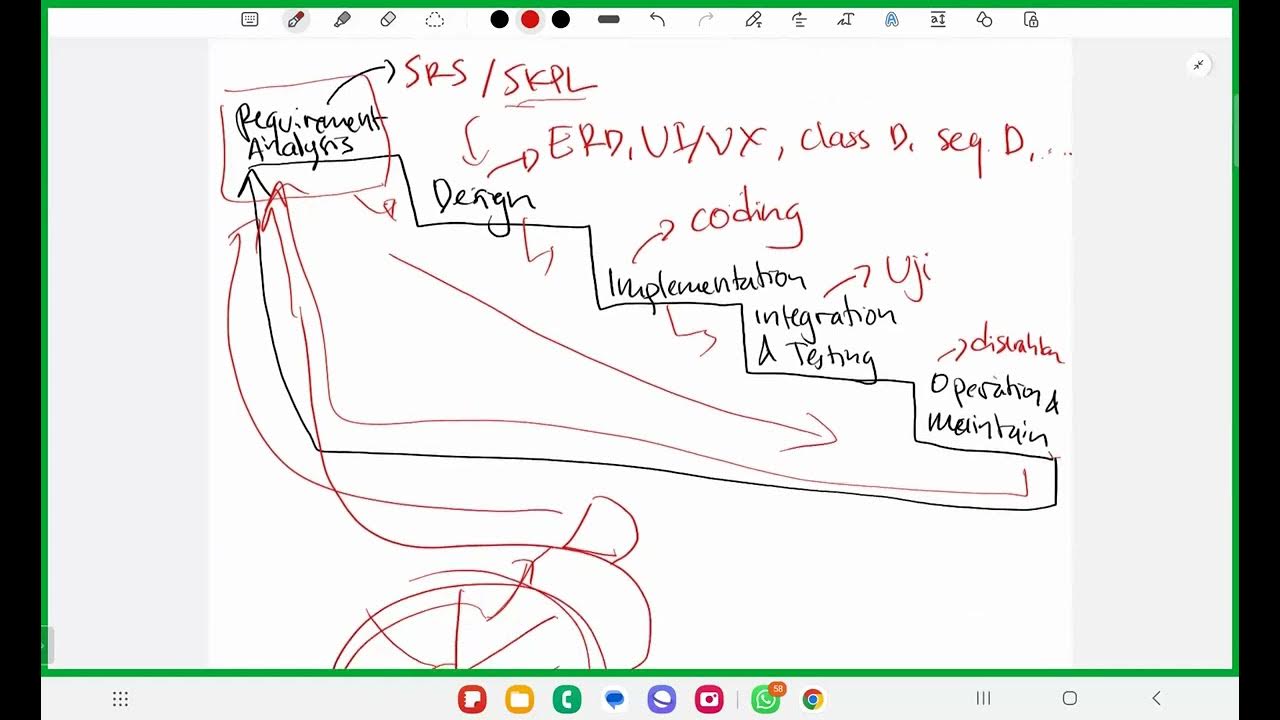RPL - 06 Requirement Modeling (Part 1): Scenario-based & Class Model
Summary
TLDRThis video covers the first part of requirements modeling in software engineering, focusing on scenario-based and class-based models. It highlights the importance of modeling requirements to bridge system description and design. Scenario-based models, including use cases, depict user interactions with a system, while class-based models define the objects and relationships within the system. The video provides detailed examples and diagrams, explaining key concepts like actors, use case steps, class attributes, methods, and relationships. Flow and behavioral models will be addressed in another video.
Takeaways
- 📋 Requirements modeling serves as a bridge between system description and system design, ensuring that software meets customer needs.
- 🧩 The purpose of modeling requirements is threefold: to understand customer needs, to create a foundation for system design, and to establish requirements for validation after the system is built.
- 📄 There are four main types of requirements models in software engineering: scenario-based models, class-based models, flow models, and behavioral models.
- 👥 Scenario-based models include use cases and user stories, focusing on interactions between users and the system. They help define actors, goals, preconditions, scenarios, and exceptions.
- 🔄 Activity diagrams are often used to complement use cases by illustrating the flow of actions in a scenario, including alternative scenarios.
- 🏷️ Class-based models, used in object-oriented analysis, focus on defining objects, their attributes, operations, and relationships between objects.
- 📦 A class diagram includes a class name, attributes, methods (operations), and relationships with other classes (such as associations and dependencies).
- 🔗 Common class relationships include aggregation, association, and dependency, helping define how different classes interact with each other.
- 📂 Package diagrams help organize classes into logical groups based on their relationships or similarities, making large systems easier to manage and understand.
- 📝 The requirements modeling process ensures that the system is fully defined and can be validated against customer needs once developed.
Q & A
What is the primary purpose of requirements modeling in software engineering?
-The primary purpose of requirements modeling is to describe what the customer needs, build a foundation for software design, and establish a set of requirements that can be validated once the software is developed.
What are the four types of requirements models mentioned in the video?
-The four types of requirements models mentioned are scenario-based models, class models, flow models (like data flow diagrams), and behavioral models (such as state and sequence diagrams).
What is a scenario-based model, and what does it typically include?
-A scenario-based model, such as a use case or user story, describes interactions between a user (actor) and the system. It typically includes the actor, the goal, preconditions, the main scenario, alternative scenarios, exceptions, and the priority of the use case.
How does a use case help in the requirements modeling process?
-A use case helps by outlining the specific interactions between users and the system, making it easier to understand the user’s needs, define system requirements, and serve as a reference point during system validation.
What is a class-based model in object-oriented analysis?
-A class-based model describes objects that the system will manipulate. It includes class definitions, attributes, operations, relationships between classes, and collaboration among classes.
What are the key components of a class diagram?
-The key components of a class diagram include the class name, attributes (data fields), operations (methods or functions), and relationships (associations, dependencies) between classes.
What types of relationships can exist between classes in a class diagram?
-Three common types of relationships between classes are part-of (composition), is-a (inheritance), and dependency (one class relies on another).
What is the purpose of CRC (Class Responsibility Collaborator) cards in class modeling?
-CRC cards are used to identify and organize relevant classes based on their responsibilities and collaborations. They help in reviewing and refining class structures during object-oriented software development.
How is an activity diagram used to support a use case?
-An activity diagram visually represents the flow of interactions within a use case scenario, including the main and alternative scenarios. It provides a step-by-step sequence of actions in the form of symbols and notations.
What role do package diagrams play in class-based models?
-Package diagrams group related classes into packages, helping to organize and manage complex systems by visually showing the logical grouping of classes and their relationships.
Outlines

This section is available to paid users only. Please upgrade to access this part.
Upgrade NowMindmap

This section is available to paid users only. Please upgrade to access this part.
Upgrade NowKeywords

This section is available to paid users only. Please upgrade to access this part.
Upgrade NowHighlights

This section is available to paid users only. Please upgrade to access this part.
Upgrade NowTranscripts

This section is available to paid users only. Please upgrade to access this part.
Upgrade NowBrowse More Related Video
5.0 / 5 (0 votes)





